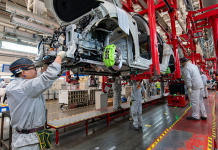Soon after graduation, Wu Mengwei, an electronic and information engineering major, followed his passion and became a writer contributing to online novel websites. He usually works five to six hours every night and jots down some 4,000 to 6,000 words.
“I’m not really a social person. I enjoy letting my thoughts flow at night and write,” Wu said. “But sitting down for too long has admittedly made me gain weight.”
Wu is among China’s 200 million who do not work for a company or any employer, a number recently released by the National Bureau of Statistics (NBS).
“Today, many people opt to work on their own or for themselves. They have more choices and can get more creative in their career pursuits, as well as can quickly respond to and change with market demand,” Zhang Chenggang, a professor at the Capital University of Economics and Business, told Beijing Review, adding that the digital age has increased job opportunities and created room for more diversified development.
Job alternatives
A guideline released by the State Council in 2020 highlighted flexible employment, including individual businesses, part-time jobs, and new occupational forms, as an important way to boost employment and increase labor income, as well as to broaden new work channels and nurture new drivers of progress.
Zhang added those who don’t work full-time under one employer for a relatively long period fall into the flex work category.
Some 12.69 million new urban jobs were added last year, an increase of 830,000 from 2020, Ning Jizhe, head of the NBS, told a press conference in January. The surveyed urban unemployment rate, in turn, fell under the 5.5-percent target.
Ning attributed the job market performance partly to the job creation fueled by China’s continuous economic recovery and development, as well as the country’s pro-employment policy which has expanded job opportunities for college graduates and rural migrant workers.
Although employment in some industries such as service, manufacturing and construction contracted, that in certain other sectors expanded, contributing to overall job market stability, Ning said.
In addition, “new business forms boost the consumer market by making service consumption more convenient, and employ a large workforce to meet the needs of a widely dispersed clientele,” Zhang said.
Food delivery is one such business form. When COVID-19 put China in a bind over the first half of 2020, the number of registered couriers on food delivery giant Meituan was nearly 4 million. “The delivery service market offered income opportunities for a large number of groups with a relatively low level of education and skills, or who were temporarily unemployed due to the epidemic,” Zhang said.
On platforms like Meituan, people can register to become part-time couriers, taxi drivers or manicurists who offer house calls. Fixed working hours are usually not a requirement, which means one can work more or less according to their own schedule.
Zhang said job quality of flexible employment in the digital age has improved, mainly in terms of more secure income and flexible working hours. “Flexible employees who work through the platform are mainly paid for their hours and per order, which helps avoid wage arrears,” he explained.
Digital technology has driven the development of the sharing and online economies, Ma Liang, a researcher with the National Academy of Development and Strategy under Renmin University of China (RUC), believes.
Ma said content platforms such as cloud customer service, short videos, and online education have created perfect conditions for flexible employment, expanded the extension of college students’ career choices in terms of time, space and form, and enriched the variety of supply-side employment positions.
China is expected to see 10.76 million new graduates pour into the job market from the country’s universities and colleges this year, 1.67 million more than last year, according to the Ministry of Education.
Over the past two years, 16 percent of college graduates in China have opted for flexible employment, according to data from the China Higher Education Student Information and Career Center.
More than 1.6 million people are working in jobs related to live-streaming, an increase of nearly 300 percent between 2020 and 2021.
But some voices are saying that flexible employment is a nice way of saying you’re unemployed. “I don’t believe that flex work equals unemployment or taking on the odd job here and there. For me, it’s a new way of life and a new way to carve out a career based on what I’m good at and interested in. This way, I can follow my heart and my passion,” Huang Zixuan, a content creator with over 30,000 followers on popular platform Bilibili who mainly produces online gaming and electronic device unboxing videos, told Beijing Review.
However, Huang added he does face challenges in managing his time and striking a balance between work and life. He also gets stressed out by unstable income and unfriendly viewer comments.
Some people choose not to work at a company because they would like to manage their own schedules. Online store owner Wang Shenghui once signed up as a driver on ride-hailing platform DiDi Chuxing when business wasn’t going well. “I drive to earn some extra cash whenever I want. Right now, my online store has picked up again, so I can stop driving and focus on my main business. When I’m worn-out, I can take a break and travel during the off-peak season as most people are, basically, at work. It feels great to have control over the rhythm of my life,” Wang said.
“Sure, I might seek a stable job when I’m no longer able to support myself this way, but the important thing is that I do have a say in my career choice,” Huang, the content creator, said.
The flex trend is not just limited to China. A document released by the International Labor Organization in 2015 read that over the past few decades, in industrialized and developing countries alike, there has been a marked shift away from standard to non-traditional employment, and the transformations in the world of work, regulatory changes and macroeconomic fluctuations and crises have all contributed to this evolution.
The transformation includes changes in economic structures, from agriculture and manufacturing to services, increased pressure from globalization, technological revolution as well as changes in entrepreneurial strategies. -The Daily Mail-Beijing Review News Exchange Item






